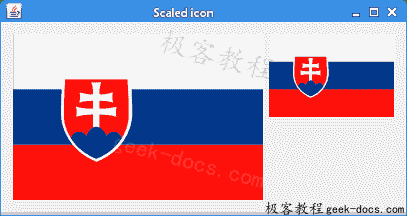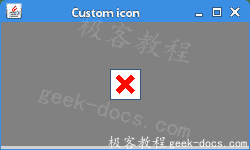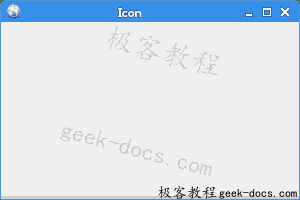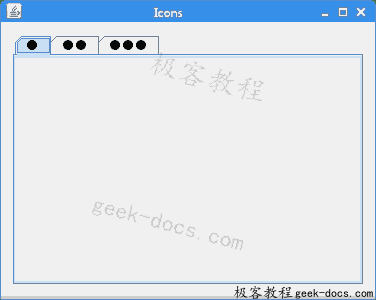在本教程中,我们将使用ImageIcon。 我们将绘制一个图标,缩放一个图标,创建一个自定义图标,并将图标放入各种 Swing 组件中。
ImageIcon
Icon是固定尺寸的小图片,通常用于装饰组件。 ImageIcon是Icon界面的实现,可从图像绘制图标。 可以从 URL,文件名或字节数组创建图像。
paintIcon(Component c, Graphics g, int x, int y)
Icon's paintIcon()方法在指定位置绘制图标。
ImageIcon构造函数
ImageIcon具有多个构造函数,包括:
ImageIcon(byte[] imageData)-从字节数组创建ImageIcon。ImageIcon(Image image)—从图像对象创建ImageIcon。ImageIcon(String filename)-创建一个ImageIcon指定的文件。ImageIcon(URL location)-从指定的 URL 创建一个ImageIcon。
ImageIcon可以处理 PNG,JPEG 和 GIF 图像。 如果要使用 BMP 或 ICO 图像,可以使用 image4j 库。
绘制图标
在第一个示例中,我们将在面板上绘制一个图标。
PaintingIconEx.java
package com.zetcode;
import java.awt.Container;
import java.awt.Dimension;
import java.awt.EventQueue;
import java.awt.Graphics;
import javax.swing.GroupLayout;
import javax.swing.ImageIcon;
import javax.swing.JComponent;
import javax.swing.JFrame;
import javax.swing.JPanel;
class DrawingPanel extends JPanel {
private ImageIcon icon;
public DrawingPanel() {
loadImage();
initPanel();
}
private void loadImage() {
icon = new ImageIcon("book.jpg");
}
private void initPanel() {
int w = icon.getIconWidth();
int h = icon.getIconHeight();
setPreferredSize(new Dimension(w, h));
}
@Override
public void paintComponent(Graphics g) {
super.paintComponent(g);
icon.paintIcon(this, g, 0, 0);
}
}
public class PaintingIconEx extends JFrame {
public PaintingIconEx() {
initUI();
}
private void initUI() {
DrawingPanel dpnl = new DrawingPanel();
createLayout(dpnl);
setTitle("Image");
setLocationRelativeTo(null);
setDefaultCloseOperation(JFrame.EXIT_ON_CLOSE);
}
private void createLayout(JComponent... arg) {
Container pane = getContentPane();
GroupLayout gl = new GroupLayout(pane);
pane.setLayout(gl);
gl.setHorizontalGroup(gl.createSequentialGroup()
.addComponent(arg[0])
);
gl.setVerticalGroup(gl.createParallelGroup()
.addComponent(arg[0])
);
pack();
}
public static void main(String[] args) {
EventQueue.invokeLater(() -> {
JFrame ex = new PaintingIconEx();
ex.setVisible(true);
});
}
}
该示例将文件系统中的图像加载到ImageIcon中并将其绘制在JPanel组件上。
private void loadImage() {
icon = new ImageIcon("book.jpg");
}
我们将 JPG 图像加载到ImageIcon中。 该图像位于项目根目录中。
private void initPanel() {
int w = icon.getIconWidth();
int h = icon.getIconHeight();
setPreferredSize(new Dimension(w, h));
}
在initPanel()方法中,我们使用getIconWidth()和getIconHeight()方法确定图标的宽度和高度。 我们设置面板的首选大小以匹配图标大小。
@Override
public void paintComponent(Graphics g) {
super.paintComponent(g);
icon.paintIcon(this, g, 0, 0);
}
在paintComponent()方法中,我们使用paintIcon()方法在面板上绘制图标。

Figure: Painting icon
缩放图像
以下示例显示了缩放图像的简单方法。
ImageIconScaleEx.java
package com.zetcode;
import java.awt.Container;
import java.awt.EventQueue;
import java.awt.Image;
import javax.swing.GroupLayout;
import javax.swing.ImageIcon;
import javax.swing.JComponent;
import javax.swing.JFrame;
import static javax.swing.JFrame.EXIT_ON_CLOSE;
import javax.swing.JLabel;
public class ImageIconScaleEx extends JFrame {
public ImageIconScaleEx() {
initUI();
}
private void initUI() {
ImageIcon originalIcon = new ImageIcon("slovakia.png");
JLabel originalLabel = new JLabel(originalIcon);
int width = originalIcon.getIconWidth() / 2;
int height = originalIcon.getIconHeight() / 2;
Image scaled = scaleImage(originalIcon.getImage(), width, height);
ImageIcon scaledIcon = new ImageIcon(scaled);
JLabel newLabel = new JLabel(scaledIcon);
createLayout(originalLabel, newLabel);
setTitle("Scaled icon");
setLocationRelativeTo(null);
setDefaultCloseOperation(EXIT_ON_CLOSE);
}
private Image scaleImage(Image image, int w, int h) {
Image scaled = image.getScaledInstance(w, h, Image.SCALE_SMOOTH);
return scaled;
}
private void createLayout(JComponent... arg) {
Container pane = getContentPane();
GroupLayout gl = new GroupLayout(pane);
pane.setLayout(gl);
gl.setAutoCreateContainerGaps(true);
gl.setAutoCreateGaps(true);
gl.setHorizontalGroup(gl.createSequentialGroup()
.addComponent(arg[0])
.addComponent(arg[1])
);
gl.setVerticalGroup(gl.createParallelGroup()
.addComponent(arg[0])
.addComponent(arg[1])
);
pack();
}
public static void main(String[] args) {
EventQueue.invokeLater(() -> {
ImageIconScaleEx ex = new ImageIconScaleEx();
ex.setVisible(true);
});
}
}
窗口上显示了两个图像:原始图像及其旁边的缩放图像。
ImageIcon originalIcon = new ImageIcon("slovakia.png");
我们将 PNG 图像读取到ImageIcon中。 该图像位于项目根目录中。
int width = originalIcon.getIconWidth() / 2;
int height = originalIcon.getIconHeight() / 2;
我们使用getIconWidth()和getIconHeight()方法获得原始图像的宽度和高度。
Image scaled = scaleImage(originalIcon.getImage(), width, height);
我们将图标的Image,其 with 和 height 传递给scaleImage()方法,在其中执行缩放操作。
private Image scaleImage(Image image, int w, int h) {
Image scaled = image.getScaledInstance(w, h, Image.SCALE_SMOOTH);
return scaled;
}
getScaledInstance()创建Image的缩放版本。 我们使用Image.SCALE_SMOOTH缩放操作,该操作对图像平滑度的优先级高于缩放速度。
ImageIcon scaledIcon = new ImageIcon(scaled);
JLabel newLabel = new JLabel(scaledIcon);
我们从Image创建一个ImageIcon,并将其传递给JLabel组件。

Figure: Scaling image
自定义图标
Swing 绘画 API 也可以用于创建自定义图标。 图形上下文将传递给paintIcon()方法。
CustomIconEx.java
package com.zetcode;
import java.awt.BasicStroke;
import java.awt.Color;
import java.awt.Component;
import java.awt.EventQueue;
import java.awt.Graphics;
import java.awt.Graphics2D;
import javax.swing.Icon;
import javax.swing.JFrame;
import javax.swing.JLabel;
class MissingIcon implements Icon {
private final int WIDTH = 32;
private final int HEIGHT = 32;
private final BasicStroke stroke = new BasicStroke(5);
@Override
public void paintIcon(Component c, Graphics g, int x, int y) {
doDrawing(g, x, y);
}
public void doDrawing(Graphics g, int x, int y) {
Graphics2D g2d = (Graphics2D) g.create();
g2d.setColor(Color.white);
g2d.fillRect(x + 1, y + 1, WIDTH - 2, HEIGHT - 2);
g2d.setColor(Color.darkGray);
g2d.drawRect(x + 1, y + 1, WIDTH - 2, HEIGHT - 2);
g2d.setColor(Color.red);
g2d.setStroke(stroke);
g2d.drawLine(x + 10, y + 10, x + WIDTH - 10, y + HEIGHT - 10);
g2d.drawLine(x + 10, y + HEIGHT - 10, x + WIDTH - 10, y + 10);
g2d.dispose();
}
@Override
public int getIconWidth() {
return WIDTH;
}
@Override
public int getIconHeight() {
return HEIGHT;
}
}
class MyLabel extends JLabel {
public MyLabel(Icon icon) {
super(icon);
}
@Override
public boolean isOpaque() {
return true;
}
}
public class CustomIconEx extends JFrame {
public CustomIconEx() {
initUI();
}
private void initUI() {
JLabel lbl = new MyLabel(new MissingIcon());
lbl.setBackground(Color.gray);
add(lbl);
setSize(250, 150);
setTitle("Custom icon");
setLocationRelativeTo(null);
setDefaultCloseOperation(JFrame.EXIT_ON_CLOSE);
}
public static void main(String[] args) {
EventQueue.invokeLater(() -> {
CustomIconEx ex = new CustomIconEx();
ex.setVisible(true);
});
}
}
该示例创建一个缺少的自定义图标,并在带有JLabel的窗口上显示该图标。
class MissingIcon implements Icon {
要创建自定义图标,我们实现Icon界面。
@Override
public int getIconWidth() {
return WIDTH;
}
@Override
public int getIconHeight() {
return HEIGHT;
}
我们重写getIconWidth()和getIconHeight()方法,它们确定图标的大小。
@Override
public void paintIcon(Component c, Graphics g, int x, int y) {
doDrawing(g, x, y);
}
我们覆盖了paintIcon()方法,在该方法中绘制了图标。 Graphics对象提供了许多绘制 2D 形状并获取有关应用图形环境的信息的方法。
public void doDrawing(Graphics g, int x, int y) {
Graphics2D g2d = (Graphics2D) g.create();
g2d.setColor(Color.white);
g2d.fillRect(x + 1, y + 1, WIDTH - 2, HEIGHT - 2);
g2d.setColor(Color.darkGray);
g2d.drawRect(x + 1, y + 1, WIDTH - 2, HEIGHT - 2);
g2d.setColor(Color.red);
g2d.setStroke(stroke);
g2d.drawLine(x + 10, y + 10, x + WIDTH - 10, y + HEIGHT - 10);
g2d.drawLine(x + 10, y + HEIGHT - 10, x + WIDTH - 10, y + 10);
g2d.dispose();
}
在doDrawing()方法内部,我们绘制了图标。 该过程与paintComponent()方法中的绘制相同。 Graphics2D类扩展了Graphics类,以提供对几何,坐标转换,颜色管理和文本布局的更复杂的控制。
class MyLabel extends JLabel {
public MyLabel(Icon icon) {
super(icon);
}
@Override
public boolean isOpaque() {
return true;
}
}
我们有一个自定义的MyLabel组件。 我们将其设为不透明,即标签具有背景。
JLabel lbl = new MyLabel(new MissingIcon());
图标设置为标签组件。

Figure: Missing custom icon
ImageIcon按钮
可以将ImageIcons放置在JButton组件上。
ImageIconButtonsEx.java
package com.zetcode;
import java.awt.Container;
import java.awt.EventQueue;
import javax.swing.GroupLayout;
import javax.swing.ImageIcon;
import javax.swing.JButton;
import javax.swing.JComponent;
import javax.swing.JFrame;
import static javax.swing.JFrame.EXIT_ON_CLOSE;
public class ImageIconButtonsEx extends JFrame {
public ImageIconButtonsEx() {
initUI();
}
private void initUI() {
ImageIcon quitIcon = new ImageIcon("quit.png");
ImageIcon saveIcon = new ImageIcon("save.png");
ImageIcon homeIcon = new ImageIcon("home.png");
JButton quitBtn = new JButton(quitIcon);
JButton saveBtn = new JButton(saveIcon);
JButton homeBtn = new JButton(homeIcon);
createLayout(quitBtn, saveBtn, homeBtn);
setTitle("JButtons");
setLocationRelativeTo(null);
setDefaultCloseOperation(EXIT_ON_CLOSE);
}
private void createLayout(JComponent... arg) {
Container pane = getContentPane();
GroupLayout gl = new GroupLayout(pane);
pane.setLayout(gl);
gl.setAutoCreateContainerGaps(true);
gl.setAutoCreateGaps(true);
gl.setHorizontalGroup(gl.createSequentialGroup()
.addComponent(arg[0])
.addComponent(arg[1])
.addComponent(arg[2])
);
gl.setVerticalGroup(gl.createParallelGroup()
.addComponent(arg[0])
.addComponent(arg[1])
.addComponent(arg[2])
);
gl.linkSize(arg[0], arg[1], arg[2]);
pack();
}
public static void main(String[] args) {
EventQueue.invokeLater(() -> {
ImageIconButtonsEx ex = new ImageIconButtonsEx();
ex.setVisible(true);
});
}
}
我们有三个按钮。 它们每个都显示一个ImageIcon。
ImageIcon quitIcon = new ImageIcon("quit.png");
ImageIcon saveIcon = new ImageIcon("save.png");
ImageIcon homeIcon = new ImageIcon("home.png");
创建了三个ImageIcons。 我们将文件名传递给每个构造函数。 PNG 文件位于项目根目录中。
JButton quitBtn = new JButton(quitIcon);
JButton saveBtn = new JButton(saveIcon);
JButton homeBtn = new JButton(homeIcon);
JButton组件接受ImageIcon作为参数。

Figure: Image buttons
JFrame图标
JFrame组件可以在其标题栏中显示一个图标。 它显示在标题栏的左侧。
FrameIconEx.java
package com.zetcode;
import java.awt.EventQueue;
import javax.swing.ImageIcon;
import javax.swing.JFrame;
import static javax.swing.JFrame.EXIT_ON_CLOSE;
public class FrameIconEx extends JFrame {
public FrameIconEx() {
initUI();
}
private void initUI() {
ImageIcon webIcon = new ImageIcon("web.png");
setIconImage(webIcon.getImage());
setTitle("Icon");
setSize(300, 200);
setLocationRelativeTo(null);
setDefaultCloseOperation(EXIT_ON_CLOSE);
}
public static void main(String[] args) {
EventQueue.invokeLater(() -> {
FrameIconEx ex = new FrameIconEx();
ex.setVisible(true);
});
}
}
web.png是一个很小的 22x22px 图像文件。
ImageIcon webIcon = new ImageIcon("web.png");
我们从位于项目根目录中的 PNG 文件创建一个ImageIcon。
setIconImage(webIcon.getImage());
setIconImage()设置要显示为该窗口图标的图像。 getImage()返回图标的Image。

Figure: Icon
JLabel中的ImageIcon
在下面的示例中,我们将ImageIcons放入JLabel组件中。
ImageIconLabelEx.java
package com.zetcode;
import java.awt.Container;
import java.awt.EventQueue;
import javax.swing.GroupLayout;
import javax.swing.ImageIcon;
import javax.swing.JComponent;
import javax.swing.JFrame;
import static javax.swing.JFrame.EXIT_ON_CLOSE;
import javax.swing.JLabel;
public class ImageIconLabelEx extends JFrame {
public ImageIconLabelEx() {
initUI();
}
private void initUI() {
JLabel lbl1 = new JLabel(new ImageIcon("cpu.png"));
JLabel lbl2 = new JLabel(new ImageIcon("drive.png"));
JLabel lbl3 = new JLabel(new ImageIcon("laptop.png"));
JLabel lbl4 = new JLabel(new ImageIcon("player.png"));
JLabel lbl5 = new JLabel(new ImageIcon("pda.png"));
createLayout(lbl1, lbl2, lbl3, lbl4, lbl5);
setTitle("Icons");
setLocationRelativeTo(null);
setDefaultCloseOperation(EXIT_ON_CLOSE);
}
private void createLayout(JComponent... arg) {
Container pane = getContentPane();
GroupLayout gl = new GroupLayout(pane);
pane.setLayout(gl);
gl.setAutoCreateContainerGaps(true);
gl.setAutoCreateGaps(true);
gl.setHorizontalGroup(gl.createSequentialGroup()
.addComponent(arg[0])
.addComponent(arg[1])
.addComponent(arg[2])
.addComponent(arg[3])
.addComponent(arg[4])
);
gl.setVerticalGroup(gl.createParallelGroup()
.addComponent(arg[0])
.addComponent(arg[1])
.addComponent(arg[2])
.addComponent(arg[3])
.addComponent(arg[4])
);
pack();
}
public static void main(String[] args) {
EventQueue.invokeLater(() -> {
ImageIconLabelEx ex = new ImageIconLabelEx();
ex.setVisible(true);
});
}
}
项目根目录中有五个 PNG 文件。 它们显示在JLabel组件的窗口中。
JLabel lbl1 = new JLabel(new ImageIcon("cpu.png"));
JLabel lbl2 = new JLabel(new ImageIcon("drive.png"));
JLabel lbl3 = new JLabel(new ImageIcon("laptop.png"));
JLabel lbl4 = new JLabel(new ImageIcon("player.png"));
JLabel lbl5 = new JLabel(new ImageIcon("pda.png"));
JLabel具有一个构造函数,该构造函数将ImageIcon作为参数。

Figure: Icons in labels
JTabbedPane中的ImageIcon
JTabbedPane是 Swing 组件,允许用户通过单击选项卡在一组组件之间切换。 这些选项卡可以包含ImageIcons。
ImageIconTabbedPaneEx
package com.zetcode;
import java.awt.Container;
import java.awt.Dimension;
import java.awt.EventQueue;
import javax.swing.GroupLayout;
import javax.swing.ImageIcon;
import javax.swing.JComponent;
import javax.swing.JFrame;
import static javax.swing.JFrame.EXIT_ON_CLOSE;
import javax.swing.JPanel;
import javax.swing.JTabbedPane;
public class ImageIconTabbedPaneEx extends JFrame {
public ImageIconTabbedPaneEx() {
initUI();
}
private void initUI() {
ImageIcon icon1 = new ImageIcon("dot1.png");
ImageIcon icon2 = new ImageIcon("dot2.png");
ImageIcon icon3 = new ImageIcon("dot3.png");
JTabbedPane tbp = new JTabbedPane();
tbp.setPreferredSize(new Dimension(350, 250));
tbp.addTab("", icon1, new JPanel());
tbp.addTab("", icon2, new JPanel());
tbp.addTab("", icon3, new JPanel());
createLayout(tbp);
setTitle("Icons");
setLocationRelativeTo(null);
setDefaultCloseOperation(EXIT_ON_CLOSE);
}
private void createLayout(JComponent... arg) {
Container pane = getContentPane();
GroupLayout gl = new GroupLayout(pane);
pane.setLayout(gl);
gl.setAutoCreateContainerGaps(true);
gl.setAutoCreateGaps(true);
gl.setHorizontalGroup(gl.createSequentialGroup()
.addComponent(arg[0])
);
gl.setVerticalGroup(gl.createParallelGroup()
.addComponent(arg[0])
);
pack();
}
public static void main(String[] args) {
EventQueue.invokeLater(() -> {
ImageIconTabbedPaneEx ex = new ImageIconTabbedPaneEx();
ex.setVisible(true);
});
}
}
该示例在JTabbedPane组件的选项卡中显示ImageIcons。
ImageIcon icon1 = new ImageIcon("dot1.png");
ImageIcon已创建。
JTabbedPane tbp = new JTabbedPane();
JTabbedPane已创建。
tbp.addTab("", icon1, new JPanel());
addTab()方法的第二个参数是ImageIcon。

Figure: JTabbedPane icons
本教程专门针对 Java ImageIcon。
 极客教程
极客教程